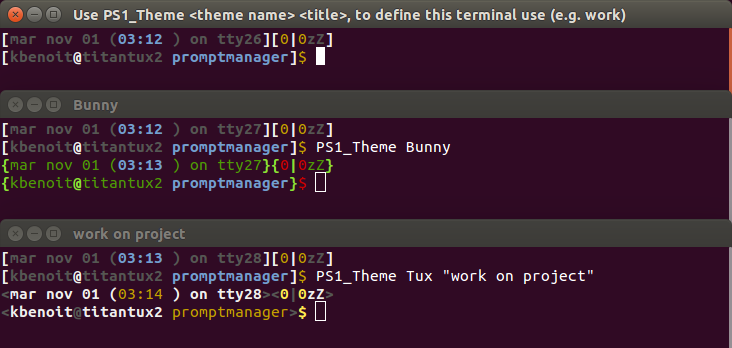A bash prompt manager with themes, colors and dynamic elements. This is useful so that your prompt reflect the environment you are in like debug mode or python virtualenv. Usually, these just add element to your PS1, no colors, no question where to add it. That's where the prompt manager is useful.
Suppose your have such prompt :
[username@hostname:~]$Then you activate a python virtualenv named pydev, your prompt look like so without color to (pydev) :
(pydev)[username@hostname:~]$Since the default might not be what you want, promptmanager give the tools to get what you want. If you tweek the activate script, your prompt might be colored including the pydev and look like so :
[username@hostname:~][pydev]$It can be easily set to your liking, but by default the prompt is configured like so :
[Mer nov 07 (04:38 ) on tty0][0|1zZ]
[username@hostname ~]$If you source the above mentioned virtualenv activate script and some other script that set you in debug mode you'll end up with a prompt like so :
[Mer nov 07 (04:38 ) on tty0][0|1zZ][pydev][debug]
[username@hostname ~]$To try, from bash, you can source like so:
source promptmanager
source promptrcAdd a DEBUG element to your prompt :
PS1_Push_Element debug DEBUGChange your theme :
PS1_Theme HulkRemove the debug element:
PS1_Pop_Element debugWhen you want to set a state in the prompt, use these methods to add/remove elements dynamically from your script. This will add support for promptmanager.
# Add element
if `declare -f PS1_Push_Element > /dev/null`
then
PS1_Push_Element debug DEBUG
else
_old_PS1=$PS1
PS1="(stuff you want to add)$PS1"
fi
#Remove Element
if `declare -f PS1_Pop_Element > /dev/null`
then
PS1_Pop_Element debug
else
PS1=$_old_PS1
fiIn gnome terminal, each terminal has a title.
By default it sets the title to the current theme name. You can also set it yourself:
PS1_Theme Bunny "Use this terminal for work"It does not seam easy to detect that you are using gnome-terminal. So if it annoy you, you can tell that you are not using it:
gnome_terminal=false PS1_Theme BnWThis is the prompt you will get by default
PS1_Clear
PS1_Push_Widget '\[$PS1_COLOR_LOW\]\d (\[$PS1_COLOR_MEDIUM\]\@\[$PS1_COLOR_LOW\]) on tty\l'
PS1_Push_Widget '\[$PS1_COLOR_HIGH\]$?\[$PS1_COLOR_BRACKET\]|\[$PS1_COLOR_HIGH\]\j\[$PS1_COLOR_LOW\]zZ'
PS1_Push_Dynamic_Content
PS1_Push_NewLine
PS1_Push_Widget '\[$PS1_COLOR_USER\]\u\[$PS1_COLOR_BRACKET\]@\[$PS1_COLOR_HOST\]\h \[$PS1_COLOR_MEDIUM\]\W'Not yet themable except for colors, but no one really want to add content dynamically to PS2
PS1_PS2='"\[$PS1_COLOR_BRACKET\][\[$PS1_COLOR_LOW\]*\[$PS1_COLOR_BRACKET\]>\[$rst\] "'PS1_Theme Kristian
PS1_Theme Hulk
PS1_Theme Bunny
PS1_Theme Princess
PS1_Theme Tux
PS1_Theme BnW
PS1_Theme PlainPS1_RenderTo define a new theme named BlueSea, according to the colors used in the default prompt, you need to define a function like so :
function __PS1_Theme_Blue {
PS1_COLOR_BRACKET=$BLUE
PS1_COLOR_LOW=$blu
PS1_COLOR_MEDIUM=$gre
PS1_COLOR_HIGH=$GRE
PS1_COLOR_ROOT=$RED
PS1_COLOR_USER=$PS1_COLOR_LOW
PS1_COLOR_HOST=$PS1_COLOR_LOW
PS1_COLOR_PROMPT=$PS1_COLOR_HIGH
PS1_BRACKET_OPEN="{"
PS1_BRACKET_CLOSE="}"
function PS1_Format_Widget {
echo "\[$PS1_COLOR_BRACKET\]$PS1_BRACKET_OPEN\[$PS1_COLOR_HIGH\]$1\[$PS1_COLOR_BRACKET\]$PS1_BRACKET_CLOSE"
}
}This can be done globally in /etc/promptrc or per user in $HOME/.promptrc
To install, copy promptmanager and promptrc to /etc and userpromptrc to "/etc/skel/".
Install system wide for new users.
sudo cp promptmanager promptrc /etc/
sudo cp userpromptrc /etc/skel/.promptrc-
Instead of having it's own file in the skel, you add userpromptrc to "/etc/skel/.bashrc".
sudo bash -c 'cat userpromptrc >> /etc/skel/.bashrc'
You can also copy it to $HOME/.promptrc.
cp userpromptrc $HOME/.promptrcNow you need to source /etc/promptmanager from /etc/profile and that depends on your distribution, but look at where it sets PS1 and replace that.

